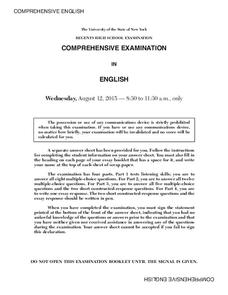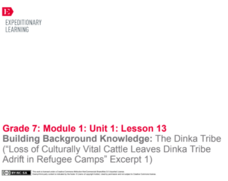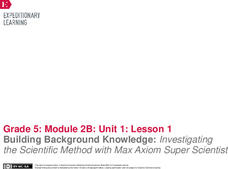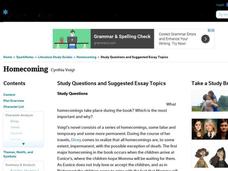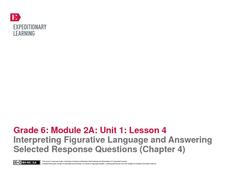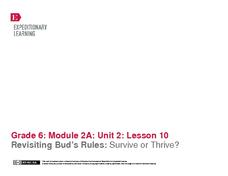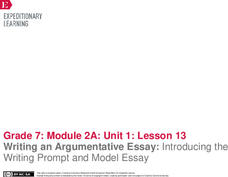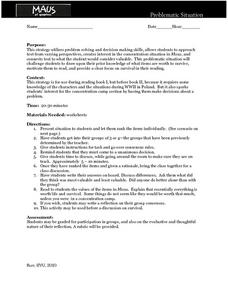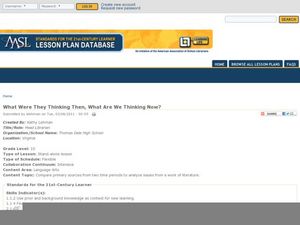Illinois Mathematics and Science Academy
A Search for Symbolism in The Great Gatsby
After reading The Great Gatsby, groups return to the text and note passages where Fitzgerald uses symbols and color imagery in his narrative. They then develop a presentation that explains the context, the implications, and possible...
New York State Education Department
Comprehensive English Examination: August 2015
Looking at literature through a critical lens helps readers connect the text to the larger world. An essay examining the theme "There is no ill in the world without a remedy" forms the main part of a sample comprehensive English...
PBS
The Power of Personal Narrative
Personal narratives are powerful things. Whether told from the first-person or third-person point of view, whether in the form of an essay, a short story, novel, or video, whether fiction or fact, they capture readers and give them...
PBS
Shifting Perspectives in Toni Morrison's Beloved
An interactive provides readers with an opportunity to record their reactions to Beloved, Toni Morrison's powerful narrative based on the life of Margaret Garner. Prompts ask them to consider how the shifting point of view contributes to...
EngageNY
Building Background Knowledge: The Lost Boys of Sudan
Get deep! Teach scholars how to make connections between texts to deepen their understanding of a topic. Using the resource, pupils read and annotate a short informational text about Sudan's Civil War and refugee crisis. Next, they...
EngageNY
Building Background Knowledge: The Dinka Tribe (“Loss of Culturally Vital Cattle Leaves Dinka Tribe Adrift in Refugee Camps” Excerpt 1)
Text annotations help readers track essential ideas. Pupils continue reading and annotating an informational article about Sudanese tribes, connecting it with A Long Walk to Water by Linda Sue Park. They also begin writing about their...
EngageNY
Building Background Knowledge: Investigating the Scientific Method with Max Axiom Super Scientist
Let's have a look at something different. Scholars take a look at the text Investigating the Scientific Method with Max Axiom Super Scientist and discuss how the structure, graphics, and images appear different than previous works they...
Spark Notes
For Whom The Bell Tolls by Ernest Hemingway: Study Guide - Essays
Included here are three short study questions and five essay topics for the novel For Whom The Bell Tolls. Consider using these in an upcoming final assessment, but also remember that many high schoolers use SparkNotes to prepare for...
Spark Notes
Homecoming by Cynthia Voigt: Study Guide - Essays
Use an online interactive literature instructional activity to test comprehension and critical understanding of the book, Homecoming. Learners respond to eight short answer and essay questions about Cynthia Voigt's novel. Answers to...
EngageNY
Interpreting Figurative Language and Answering Selected Response Questions (Chapter 4)
To prepare for an assessment of how well individuals are progressing with their ability to identify and analyze figurative language and its effect on tone and meaning, pairs work through Chapter Four of Christopher Paul Curtis'...
EngageNY
Revisiting Bud’s Rules: Survive or Thrive?
Bud followed a series of rules from Bud, Not Buddy by Christopher Paul Curtis. The question is, how did he use those rules to thrive or survive? After a grand discussion, class members explore the novel to locate and cite textual...
Prestwick House
The Things They Carried
The Things They Carried, Tim O'Brien's powerful collection of vignettes about the experiences of a platoon of soldiers during the Vietnam War, serves as a text for a crossword puzzle. The 23 clues asks readers to recall characters,...
EngageNY
Writing an Argumentative Essay: Introducing the Writing Prompt and Model Essay
Pupils begin the writing process in preparation for an end-of-unit essay based on Katherine Paterson's Lyddie. To get started, they read and discuss a model essay and learn about the similarities and differences between argumentative and...
Penguin Books
A Teacher’s Guide to the Signet Classics Edition of The Awakening by Kate Chopin
"Immoral!" "Scandalous!" When published in 1899, Kate Chopin's The Awakening was not well received. The novel traces the tragedy of Edna Pontellier, who rebels against the strictures placed upon her as a woman and mother. However, the...
K20 LEARN
Memory Haiku: The Great Gatsby and the Sense of Smell
Scholars learn how smells evoke early childhood memories and apply that knowledge to a character from F. Scott Fitzgerald's The Great Gatsby. After finding a passage from the novel that references smells, they craft a haiku and a...
Curated OER
Running Out of Time: Picture Book Activity
Ease your class into reading Running Out of Time by first reading The Boy Who Stopped Time, a picture book with some similar concepts and themes. After a reading of the story, learners participate in a discussion and journaling exercise.
Curated OER
Bronze Bow
Explore ancient Rome through reading The Bronze Bow by Elizabeth George Speare. Readers activate prior knowledge by examining objects that relate to the story and predict the significance of the items. Their curiosity is aroused through...
Curated OER
Night: Socratic Questioning Activity
We construct meaning through discussion, so help your readers of Elie Wiesel's work Night with a socratic questioning activity. The strategy is outlined on the first page, and the second page offers some example questions you give to...
Curated OER
Lesson Plan 8: Setting and Mood
What mood does this story evoke? How are setting and mood linked? Young novelists explore the different emotions brought about by writing, starting by journaling things that inspire their own feelings. Examine the word mood, looking into...
Curated OER
Pride and Prejudice: Biopoem
Describe yourself or a character from Jane Austen's Pride and Prejudice with a biopoem activity. Using the provided format, kids write their own characteristics or the character traits from the novel to create a poetic portrait.
Curated OER
Maus: Problematic Situation Strategy
Do people really need “a newer, bigger Holocaust” in order to change? Or is it possible that by making text-to-self connections to the stories of others people that they can change? In order to connect to Art Spiegelman’s Maus, class...
Curated OER
Dr. Jekyll and Mr. Hyde: Request Strategy
Model for readers how to develop effective questions with a request strategy for questioning. Text-explicit, text-implicit, and experiential based questions are the focus. Step-by-step instructions are included for the strategy that...
Curated OER
Pudd'nhead Wilson: Guided Imagery
Inspire thought around some of the themes of Pudd'nhead Wilson with a visualization activity. As you read a passage, learners close their eyes and picture the scene. A writing exercise and discussion follow.
Curated OER
What Were They Thinking Then, What Are We Thinking Now?
Choosing an issue from a play or novel, researchers find two primary sources from different time periods to compare how people's views have changed. Many questions are listed to guide young writers. In the end, learners produce a...
Other popular searches
- Reading Novels Grade 5
- Reading Novels for Children
- Reading Novels and Tests
- Reading Novels Strategy
- Reading Novels Esl Adults
- Paired Reading Novels



